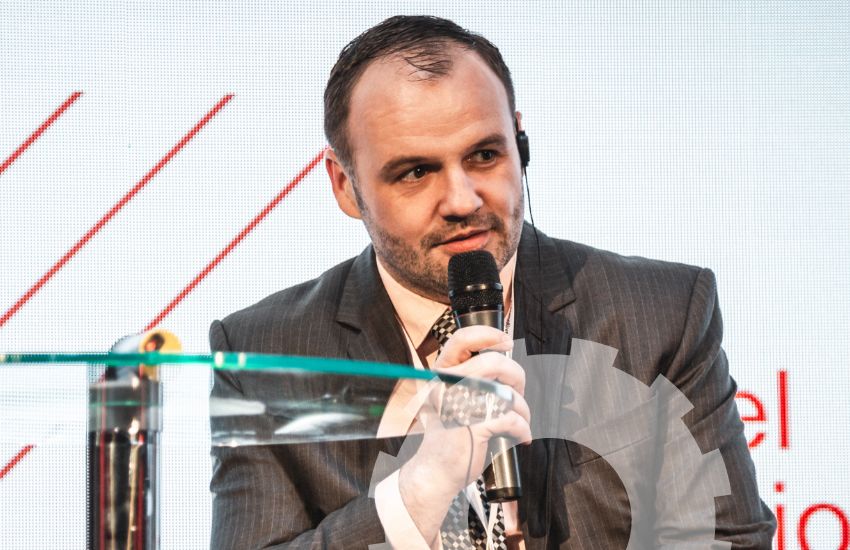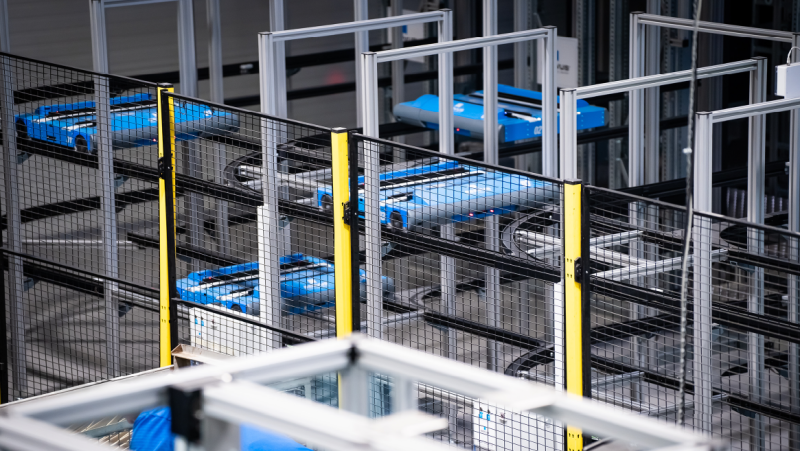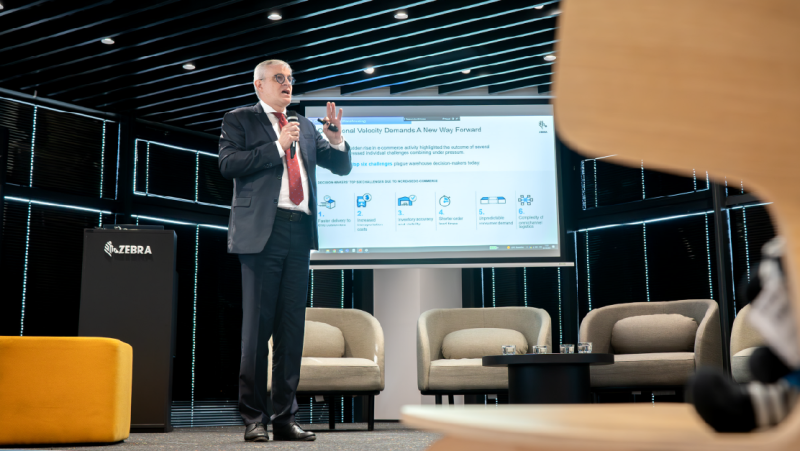“Above All, Communicate Your Automation Internally,”
- Automation
- Interview
advises Jiří Ovesný, founder of the logistics consulting firm INTRALOG SERVICES. He has been working in logistics and industry for thirteen years, and he currently provides consulting focused on automation, improving process effectiveness and putting Industry 4.0 into practice. We asked him for his opinions on how to approach automation and what to focus on right away in the project planning phase.
Please describe the areas that Intralog helps its customers with.
Our activities include (among others) logistics consulting with the aim of making processes better, faster, cheaper or otherwise more optimal. We generally arrive at a project through one of two different routes.
The first is open discussion with the client about how to improve their existing operations, where we often e.g. encounter routine operations that outright demand automation. In these situations, we ourselves are often the actual creators of the need to automate.
The second type of situation is the one where our partner is in the middle of expanding their operations or moving, and they turn to us for “greenfielding” their logistics. In these projects, the defined task is often an attempt to propel the client’s existing logistics in terms of both processes and technologies, which means a good foundation for the use of automation technologies.
What is your role in the project, then?
Our roles vary. In general, we design various forms of logistics automation for the client. Our efforts include discussions with users, presenting alternative solutions and creating the task definition for the job of selecting a supplier. However, there have also been projects where we were an integrator, that is, we assembled a requested bespoke solution out of components from multiple suppliers. In these, we were at the same time the guarantor for the solution’s long-term sustainability, functionality and conformance to the parameters that we declared at the project’s beginning.
Another case here is the projects where we take part in the supplier selection process with a clearly defined task and a fairly tangible idea of the specific technological solution. Generally, we are approached with a request for specific software solutions or the development of a specific technology. I personally, however, prefer the first variant, where our role is to be the initiator of changes.
Even if the client comes to us at the beginning with a desire for automation, it can all end up with no automation and yet with a much more effective solution in the end.
When do companies approach you, and with what kinds of requests?
Especially in recent years, our first contact with the client will be initiated due to their need for automation or a transition to Industry 4.0, without their having a clear goal. That’s the kind of premise we start with. One key moment after that is an open, general discussion on what automation means, what can and can’t be automated, etc.
Then comes the second phase, where we’re collecting data or starting detailed discussions on what must be done for automation to have any chance at life. Here clients often learn that they must either fundamentally tweak a much broader spectrum of processes or will have to give up on broad automation and focus on automating individual processes, where there’s much less of background needed.
We try to push projects ahead in a way that always keeps them beneficial for the end-user. Even if the client comes to us at the beginning with a desire for automation, it can all end up with no automation and yet with a much more effective solution in the end. This likely won’t rob the client of that which many companies are built upon today: flexibility and the ability to quickly and easily change their internal processes and their production based on their customers’ needs. In practice, this kind of requirement excludes massive automation. Clients from automotive are a classic example: “We don’t have this part, or the car hasn’t reached us from the manufacturer, so now let’s change our production and produce a different part.” This approach doesn’t work with automation.
When we step into an ongoing selection process, the borders and the main direction have essentially been set. That can lead to us closing off the path for other technologies, even though they could potentially be better.
Why is it a better variant for the customer to have an advisor even before they approach other suppliers?
When we step into an ongoing tender, an idea already exists for what the result should be, and to a large extent that shuts the door on alternative solutions and technologies for the given assignment. Automation offers a vast range of available technologies, from autonomous forklifts to conveyor technologies to robots and cobots. There truly are a lot. When we step into an ongoing selection process, the borders and the main direction have essentially been set. That can lead to us closing off the path for other technologies, even though they could potentially be better. For this reason, I prefer a greenfield, an “empty playing field”, where the ball is in the middle and we can kick it in any direction. That way, we can present lots of proposals and alternatives.
With multiple people taking part at the beginning of the project, including future end-users, that leads to, in my experience, an interesting workshop where we’re able to come together on some very interesting solutions. They can be variously assembled and hybrid, but the result is, in my experience, much better than when we have borders and we have to move around solely within them. This kind of approach brings far more possibilities for ultimately making the project less expensive. If we can work with how different elements can be mixed and interconnected, or assemble or integrate multiple systems together, that brings the user real savings. A significantly larger space for working with the price than when promoting, for example, a large and robust solution with the method “this here is what I want.” This kind of approach is negatively reflected in the tender which collapses into just one goal: “Getting what I want into the budget that I have.”
What foundation do you work from when proposing ways to improve logistics?
At the start we go into their operations – go through the plant and start chatting about the place from which automation should start or what it should concern. These are parts of the primary analysis, and later on a deeper audit. Various layers in which the given company lives are gradually uncovered: how individual users work and how they take part in specific processes. And many times, management doesn’t directly see this. They perceive the operation’s outputs, but the way in which the company arrives at them is very often hidden. But the processes work, and we don’t want to come in and say that it’s all wrong. People in the operation know why they do it this way. Through evolution or a natural route, they arrived at it. If that’s how they work and it all works, there’s a reason for that. We try to discuss with them and find a path for improving the given process or activity technologically, supporting it systematically, or directly automating it.
Who is generally in charge of automation at a company?
Either a company has someone who wants to execute such a project and wants to head out in a new direction, or it’s about a person who’s been tasked with such a project from above. Naturally, it’s faster when there’s someone at the company who has both enthusiasm and decision-making powers. Ideally, they will personally know that their logistics processes have to change, want to change them and be able to convince their team and the other key people of this. Then it’s easy to move the project forward. We have had excellent experiences with people like this from middle management.
I tell the customer that it is often very effective to have someone whose only responsibility is this project and who will move it forward. Their position has a number of other nice benefits, because they are able to mediate and to balance the pressures of different groups inside the company and can give everyone a unified goal.
For the management as well, it’s advantageous for there to be a clear goal that has only one priority and isn’t fragmenting. There’s a sort of schizophrenia – the logistics manager gets the project and is to move it forward, then the inspection day arrives, and he says that it didn’t happen because he missed this deadline, we couldn’t do this-or-that because we were tackling an acute situation in logistics. And that’s momentarily a greater priority than automation. The top manager can’t sanction them for not doing it, because the logistics manager was working on things that are vitally important for the company. If they have a project manager from outside who isn’t loaded down with day-to-day tasks at the company, that’s ultimately a benefit for the company.
It’s about choosing one partner at one moment, with the other partners hooked in to them.
How should companies choose a project management partner then?
There’s no general rule or panacea; it’s about people. If we’re truly in the early phase of a project with someone, I try to convince them to choose the person with whom they’ll go forward, because fragmentation of information is unbelievably draining for everyone involved. Not just for us, but also for the potential ordering party, that is, the customer. It’s too demanding to share all the information along several channels, to different entities and of course to be able to provide serious feedback on that information. You need to decide with whom you’ll go into it, whom you’ll believe and walk the path with that person. You can’t beat this path with thirty people, it doesn’t work. Eighty percent of the people you come to at the start of the project will fall away as a result, because they won’t want to invest time into something they won’t be interested in or for which they won’t receive the needed information that it will lead somewhere. There’s nothing left but to trust somebody and dive in.
It’s about choosing one partner at one moment, with the other partners hooked in to them. It might be a university, a consulting company, a technology company that produced part of the solution – for example its software. And the customer has to trust this company enough to put it in charge of assembling the whole project. Our task is to create a solution and show the end-user what the possibilities are – the ideal variant and the economical variant, where we say that it’s not operationally optimal, but it’s ideal from the standpoint of price/performance. There can be multiple entities, but it’s important for the customer to decide for just one entity that they trust and with which they’ll head down the path.
You can, of course, go a second route, which is also a fairly common one – people peck at information, invite firms to a workshop – but this generally just fizzles out. If someone has the time to work on it this way, we don’t try to stop them. Intuitively I would say that this sort of customer is on the decline and there are increasing numbers of those for whom time is expensive enough that they first do research, and then based on their initial market information, they address partners, invite them and then choose one with whom they will go into the project. The project thus has continuous development. I have the pleasure of stating that these are on the rise.
The variant you’ve described is suitable for large solutions where it’s not very clear at the start how they will ultimately look. But if for example I only wanted to acquire a VNA, I would approach a forklift supplier and then choose the best one based on some parameters, right?
Naturally; I was speaking about projects where there’s a larger degree of added value, i.e. optimisation. If someone is interested in just having VNA, and arrives at that based on multiple recommendations saying that this is truly more beneficial for them than having a traditional reach-truck warehouse, there’s no point in having a project manager to move things forward.
Automation is great for routine operations. The larger the degree of variability you need, the harder automation is to apply.
People gather information in other places long before a project starts. How prepared are they? And what are the expectations with which customers begin their work on automation?
People generally gather information that leads them to believe that automation would be useful at their company: from trade fairs, seminars and case studies where they see the results. Then they say to themselves: “I’d like that.” However, none of these events or case studies describes the process that led to that in detail, that is, the part of the iceberg that’s underwater. The customer then arrives with their great expectations, and here we start running into problems. That’s also what shapes our corrections to the task description, where we inform the customer on what information they need in order for automation to work.
For this we use either a microanalysis or a logistics audit; if it’s a matter of a broader spectrum of operations or an extensive process where we gather information on how life really looks at the firm. There we find out that for a lot of processes, the company isn’t gathering data, they don’t have any idea of what source documents and information they need internally for ongoing management of their automation. For example, they don’t have information about what they pack their products onto – what pallet types, what their dimensions are, weight deviations, size deviations, in short the variety, the minor specifics that they have at their operations. Because the processes are working, often the person who is in charge of automation has no idea what operators encounter day-to-day.
We start collecting this information, showing them the details and shaping the task description. Sixty percent of the automation projects in the Czech Republic and Slovakia have come to grief because the decision-maker had no idea how the company worked in detail. If they wanted to retain variability of their operations, the automation didn’t work.
That brings us to the fact that automation is great for routine operations. The larger the degree of variability you need, the harder automation is to apply and thus the more expensive it is. Those are aspects that shape great expectations. We assemble them side by side and go on with our discussions. Only in exceptional cases do we say that something is technically impossible; we tend rather to say: “Yes, that’s possible, but under these conditions.”
Most often we reach a phase where we say: “Good, these processes make sense to automate to meet our partner’s expectations. We won’t work on the rest right now; we’ll create a microclimate for the pilots to work and begin systematically working on being able to automate the other processes or activities as well.” Then this becomes a continuous process. So far during my career, I have never experienced a project where someone said: “I want to automate,” within five years they automated, and that was that. In the vast majority of cases, even after the deployment of automation, the need develops, takes a direction, changes over time, just like the customer’s need in light of the product life cycle, new products, or new types of production and so on. As soon as a company dives into something like this, it is, in my opinion, a never-ending story.
Not even today is the message resonating that automation isn’t here to take people’s jobs, but rather because there aren’t enough people or human labour is valuable.
So what should people focus on at the start of a project besides the already-mentioned process mapping?
It’s definitely communication inside the company. Not even today is the message resonating that automation isn’t here to take people’s jobs, but rather because there aren’t enough people or human labour is valuable. People are too valuable to do the given activity. They either have to be far more efficient than a machine could be, or they have to work on activities with a higher degree of added value.
Because of this, many companies don’t want communication when we’re doing an analysis. They don’t want us to tell people that they’re thinking about automation, because we would terrify them, which in my opinion is wrong. A company that has core employees that it’s serious about should constantly inform them that it wants to keep them, and that through automation it wants to increase their qualification. Because the routine activities that people are doing manually today will be done for them by machines. They will however have 5–6 machines to operate thanks to the fact that they have abilities that a machine will never have. They will be more qualified than the machine, which is able to do certain tasks, but it remains just a machine. I think that this is very important in the preparation phase, because when this information does not make it through, lots of people dig in their heels.
Unfortunately, calculations of profitability are still to this day built on savings of human labour. Companies present it as saving a certain number of people who will no longer be needed. But what they don’t state is that people will receive new tasks, that they will increase their qualifications so that they can do different work or so that they can work with automated technology. They communicate it as if the person won’t be there, and ultimately that means: that they’ll lose their job. And that damages these projects terribly.
The second part of the preparation phase is to become aware of the labour intensity of gathering information – performing analyses, microanalyses, audits, etc. The client has to have a clear idea of what all they need to know in order to move the project ahead, automate, simply: to change something from the ground up. The reason is clear – when I cut into something (into a project, application or activity), the threads that I cut through can go very deep, down to consequences that the client did not at all suspect could be impacted.
So far we haven’t matured to the point – at least not in the Czech Republic – where the customer in such a fundamental project is aware of the fact that there’s a need to set aside extra human resources. That investments are about putting resources into the project and having them work on it. We try over and over to explain to them that there’s a need to build a project team right in the primary phase. For there to be someone who will work on the project systematically and for two counter-parties who will discuss things together as equals to be created. No matter whether that means an internal team member or a hired-out firm.
INTRALOG SERVICES
INTRALOG SERVICES is an innovative supplier and provider of comprehensive solutions for internal logistics. The company’s core idea is to provide everything from one place – from logistical analyses to solution proposals all the way to bespoke deployments. All with the aim of saving clients’ time and money.
Share article
Top stories from logistics, production and IT.
Subscribe to Aimtec Insights
By registering, you agree to the processing of your personal data by Aimtec as described in the Privacy policy.
Get top stories and articles
from Logistics, Production and IT.
Subscribe to Aimtec Insights
By registering, you agree to the processing of your personal data by Aimtec as described in the Privacy policy.








